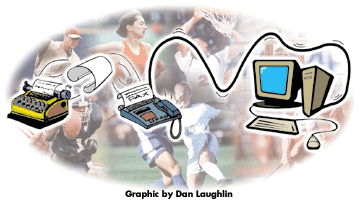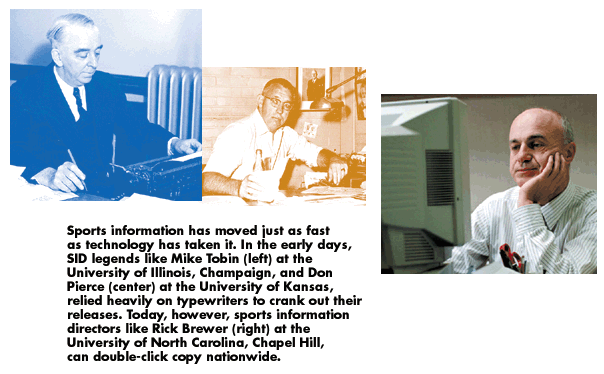The NCAA News - News and Features
The NCAA News -- August 30, 1999
The evolution of sports information
The Sports Information Age
BY GARY T. BROWN
STAFF WRITER
 Often during televised sporting events, stations will break away from the game to show viewers action from years past -- and even if the clips are from as recent as 10 or 15 years ago, the difference in the picture as well as in the sport itself is immense. So too is the difference in sports information over the past 20 years. Often during televised sporting events, stations will break away from the game to show viewers action from years past -- and even if the clips are from as recent as 10 or 15 years ago, the difference in the picture as well as in the sport itself is immense. So too is the difference in sports information over the past 20 years.
Sports information directors -- beacons of numbers, facts and words that link media to their subjects -- have gone from Royal typewriters and ballpoint pens to fax-on-demand and Web sites in what seems like the blink of an eye, which is precisely the amount of time in which today's writers, reporters and fans expect to receive their information.
As the sports SIDs cover have become faster, so has the reporting. And while technology has allowed the SID to keep up the pace, demands for covering more sports with an equal
amount of attention in light-speed efficiency can be taxing to a profession that already faces long hours and short pay.
"We live in the information age," said Boise State University SID Max Corbet, who also is the current president of the College Sports Information Directors of America. "Technology drives everything to be quicker and faster -- it's just the world we live in."
And SIDs have had to keep pace in that world. The advent of women's sports as NCAA championship sports in the early 1980s opened a whole new realm of coverage. The issue of sport equity introduced a new attitude in which nonrevenue sports commanded just as much attention as football and men's basketball.
And athletics departments have been faced with adding assistant SIDs to what once was a one-person operation in order to maintain the value that sports publicity brings back to the school.
All in all, the difference in the way things get done is night and day, but the bottom line for most SIDs remains the same -- promote the student-athlete however the process demands. And while technology may have helped in that regard, it hasn't necessarily made the SID's life any easier. Fred Nuesch, SID at Texas A&M University, Kingsville, and CoSIDA secretary, said technology in fact has doubled -- even tripled -- the SID's workload, but it's been necessary to have a chance to land that story or tidbit that shines the spotlight on the student-athlete and the school.
"Technology is the No. 1 thing that has changed the course of the profession," he said. "It has increased
media outlets for SIDs to serve, and in many cases, schools have one person do nothing but Web duties. There are an increased number of networks and publications, and cable has increased the possible number of outlets. You used to depend just on the daily newspapers and a couple of networks."
Nuesch said what has complicated matters is that each outlet has its own style as to how it wants to receive information. SIDs used to just send releases or stories and it was up to the outlets as to how they used the material.
"But now if you're sending material to them electronically, you have to prepare it they way they want it if you want to have a chance of them using it," Nuesch said. "That's very time consuming even though it increases your chances of being mentioned. But student-athletes ultimately benefit from this."
Another element of sports information that has changed is the gender of the person delivering the news. More women have flourished in the profession, and not just because women's sports are commanding more attention. But many SIDs believe there is still a long way to go before CoSIDA reaches a gender-diversity level it can be comfortable with.
"There is no doubt that we've increased the number of females in the profession," Nuesch said. "But we know we need to keep working on it. The organization is aware that this is something that needs constant attention."
 A more diverse field
A more diverse field
Only a handful of women run sports information departments at Division I schools with big-time football. Chris Anderson at the University of Nebraska, Lincoln, is one of them. She took over for the legendary Don Bryant in 1993 after 14 years as an assistant at Nebraska and Kansas State University.
Anderson pointed to a thin candidate pool and more related career options for women as reasons why the gender balance remains askew in the field. She said the pool is still mostly male, and that when there are qualified females available, other professions are recruiting them, too.
"The same way that CoSIDA is reaching out to women, so are a lot of the other fields," she said. "And there's no doubt that sports information is one of the lowest-paying fields in the journalism realm. So if you have a talented woman writer or public relations person, she's also got a host of other opportunities that probably don't all require her to work weekends.
"Sports information is very open to women and it's a profession that women can do very well in; it's just that we're still lacking so many applicants because there are other people tugging the same strong qualified women into other areas."
"We have a lot of good, young people starting out," Corbet echoed, "and it's hard to keep them in the profession. Public relations is big today and there are a lot of good jobs that don't have the SID hours and pay scale. I mean right now, all the SIDs are getting ready to face the next six months of seven-days-a-week, and for some people, especially with families, that's tough."
Mary Jo Haverbeck, associate SID at Pennsylvania State University, was hired there in 1973 specifically to publicize women's sports, but now she shares overall sports information duties with Jeff Nelson. She said she is aware of the evolution of women in the profession during her tenure, but that the candidate pool still tends to be dominated by males. Her concern, however, is whether qualified women are given a fair shot at the job.
"While administrators certainly are obligated to hire the best candidate, I'm saying that if the best candidate happens to be a woman, I'd hope there wouldn't be any resistance to hiring her," she said.
Not only is CoSIDA challenged with increasing its gender diversity, but also its ethnic diversity. CoSIDA doesn't have an accurate count of the number of ethnic minorities in the profession, but Nuesch said he knows the figure isn't where it should be. He said the organization plans to survey its membership to get an idea of where it stands -- both from an ethnic minority as well as a gender-diversity standpoint. CoSIDA also has initiated a task force to study the issue further.
Corbet said even historically black institutions struggle to hire and retain talented minorities.
"Again it goes back to finding talented individuals," he said. "They get their start in sports information -- it looks like a fun job -- but a lot of times they see the hours and pay and they're going to be snatched up pretty quick by some other career, no matter what race or gender."
The SID philosophy
Amid the changing landscape of the profession, one thing has remained constant -- the reason SIDs do the work in the first place. Sports information tends to be a loyal profession -- as well as congenial. Corbet said that often the strongest link between rival schools is the relationship between the two SIDs.
SIDs also tend to have the student-athletes in their best interests. After all, the long hours go toward promoting anyone but themselves, and that publicity reflects back on the school.
"I have always believed that a good media relations person can be as valuable to a head coach as an offensive or defensive coordinator," said Auburn athletics director David Housel. "Public perception is such an important part of any athletics program and that's where a good SID can help a coach dramatically."
Housel, who used to head Auburn's sports information staff, said an SID's most important task is to balance relationships between constituents who often are at odds. Schools may want an SID to put some spin on some potentially damaging news while a reporter is at the other end making the dirt even dirtier.
Housel said the only way to handle those situations is honestly.
"The one constant for SIDs that has been there from the very beginning of the profession and will always be there is credibility," he said. "No matter what kind of tools they have to work with, SIDs have one thing and one thing only -- credibility. They've got to tell the truth. And if they tell the media the truth and if they tell their coaches and athletics directors the truth, that can put them in some awkward situations."
"Everyone is so suspect of the other guy," Corbet added. "Coaches don't trust the media, and the media is always looking for an edge. It's partly due to the way media has changed in the last 20 years. Coaches and athletics directors are looking to put the right foot forward in the way they sell their programs and they feel sometimes that the media is just looking for another story. SIDs are caught in the middle and looking for the right balance."
That balance is at the heart of everything an SID does, whether it's balancing media and administrators, weekly releases and daily Web updates or field hockey and football.
That balance always has been there, too, whether it was a one-person show in 1959 or a fully staffed show in 1999.
Indeed, the process may be different -- the phones are speed-dial now instead of rotary -- but the end result remains unchanged: Everyone gets what they need from the SID.
|